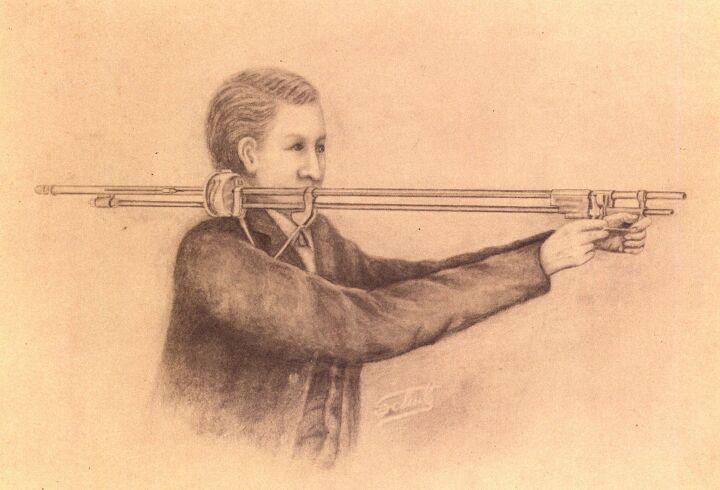If I asked you what the first first bullpup rifle was, what would you answer? The Steyr AUG? British EM-2 from the 1950s? The Faucon ‘Balanced Rifle’ from 1911 or maybe the Thorneycroft carbine from the early 1900s?
In fact the distinction goes to a much earlier rifle, designed in 1866. Patented in August 1866, by a British inventor, William Joseph Curtis, it predates all other known repeating, magazine-fed bullpup rifle designs. Not only was this odd looking rifle a bullpup but it also used one of the earliest known pump-type actions, was striker fired, had a drum magazine and an early folding stock. This makes the Curtis a truly revolutionary design for the period.

William Curtis’ 1866 ‘bullpup’ rifle, built in 1895 by Winchester (Photo by Matthew Moss, courtesy of the Cody Firearms Museum)
Back in the spring I was lucky enough to visit the excellent Cody Firearms Museum at the Buffalo Bill Center of the West there, with the help of Danny Michael, the museum’s assistant curator, I was able to examine the Curtis Rifle and film some footage for my video project, The Armourer’s Bench. I put together a short video attempting to tell the fascinating story of the Curtis and how it helped Winchester to win a major lawsuit. Check out the video below:
After examining the rifle back in April, I began researching its history and deciphering just how the weapon itself worked. It uses a slide to cycle a striker-fired action and fed from a drum magazine. It was fired from the shoulder, much like a modern anti-tank weapon, and had a folding leather strap that acted as its stock.
But how did the Curtis, a British-designed, Victorian oddity, come to be in the Cody Firearms Museum? The answer is Curtis didn’t build this example of his rifle, the Winchester Repeating Arms Company did, in 1895. If not for a corporate lawsuit on another continent, 30 years after it was designed, it is possible the Curtis, like so many other unusual firearms designs, would have slipped into obscurity. In 1894, Francis Bannerman sued Winchester for infringing on his patents when they introduced the Browning-designed, pump action, Model 1893. In response Winchester set out to scour the patent archives of Europe to find an earlier pump action design. They found three, one of which was William Curtis’ odd little rifle. Winchester built working models of each of the earlier patents they found and submitted them as evidence that Bannerman didn’t hold the sole rights to the pump action principle.

Close up of the Curtis’ brass drum magazine and leather folding ‘stock’ (Photo by Matthew Moss, courtesy of the Cody Firearms Museum)
Proving that Bannerman didn’t own the patent rights to the pump action concept Winchester won the case and in 1897, the legendary Model 1897 was introduced. The Winchester-made Curtis Rifle remained in the company’s reference collection and was transfered to the Cody Firearms Museum when the collection was gifted to them. If you’d like to know more about the Curtis and check out more photos, some cool patent and engineering drawings you can find my full blog about the curiously forward thinking Curtis here.
 Your Privacy Choices
Your Privacy Choices
